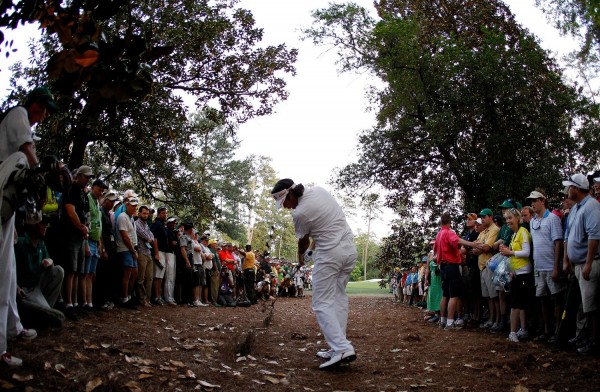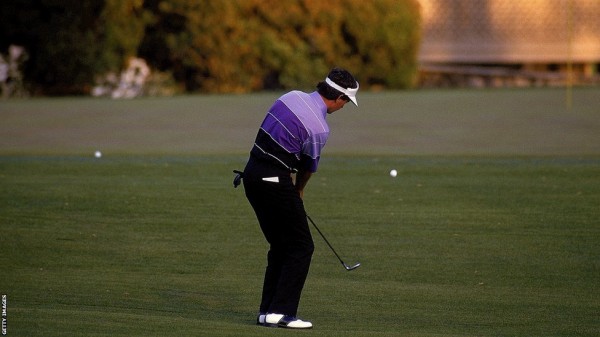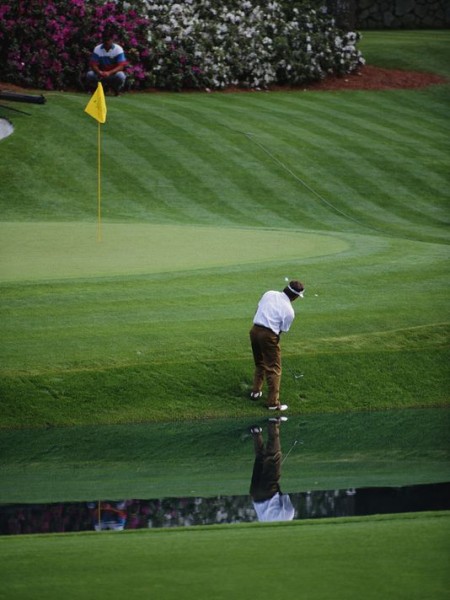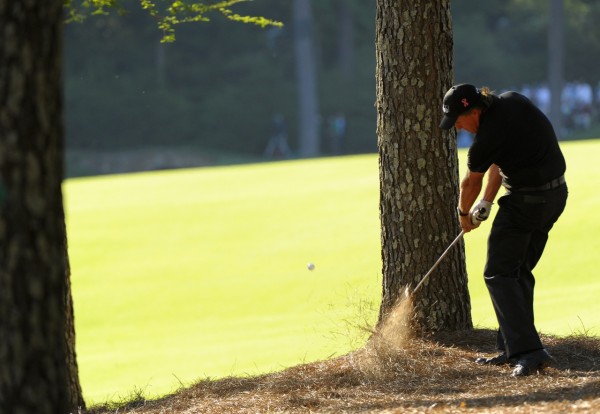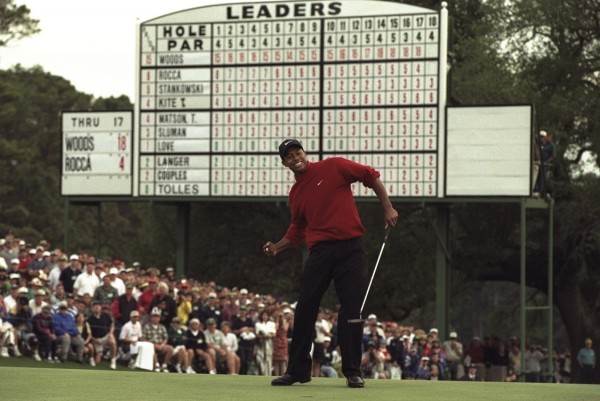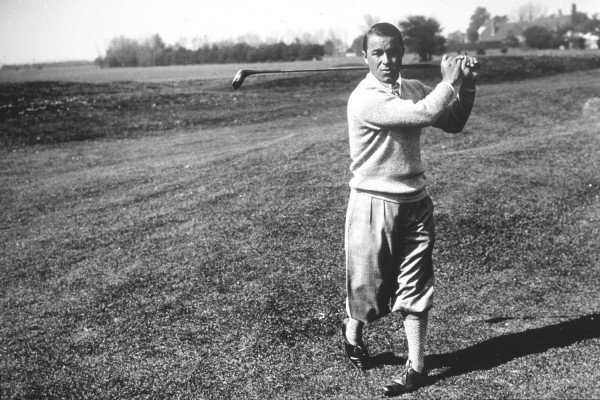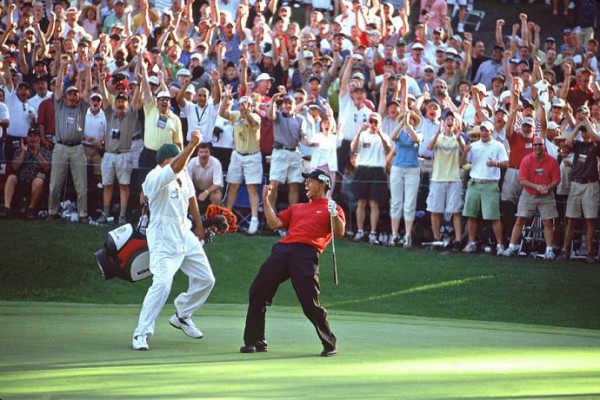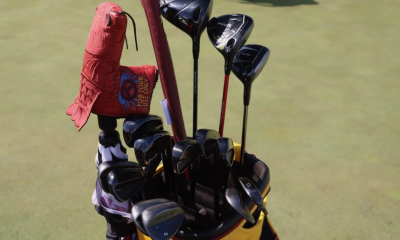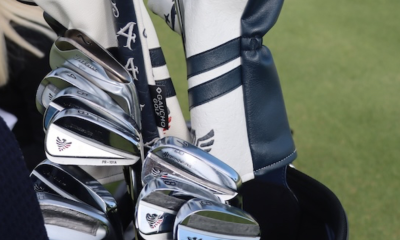Opinion & Analysis
Hole-By-Hole: The Best and Worst Shots in Masters History (Back 9)
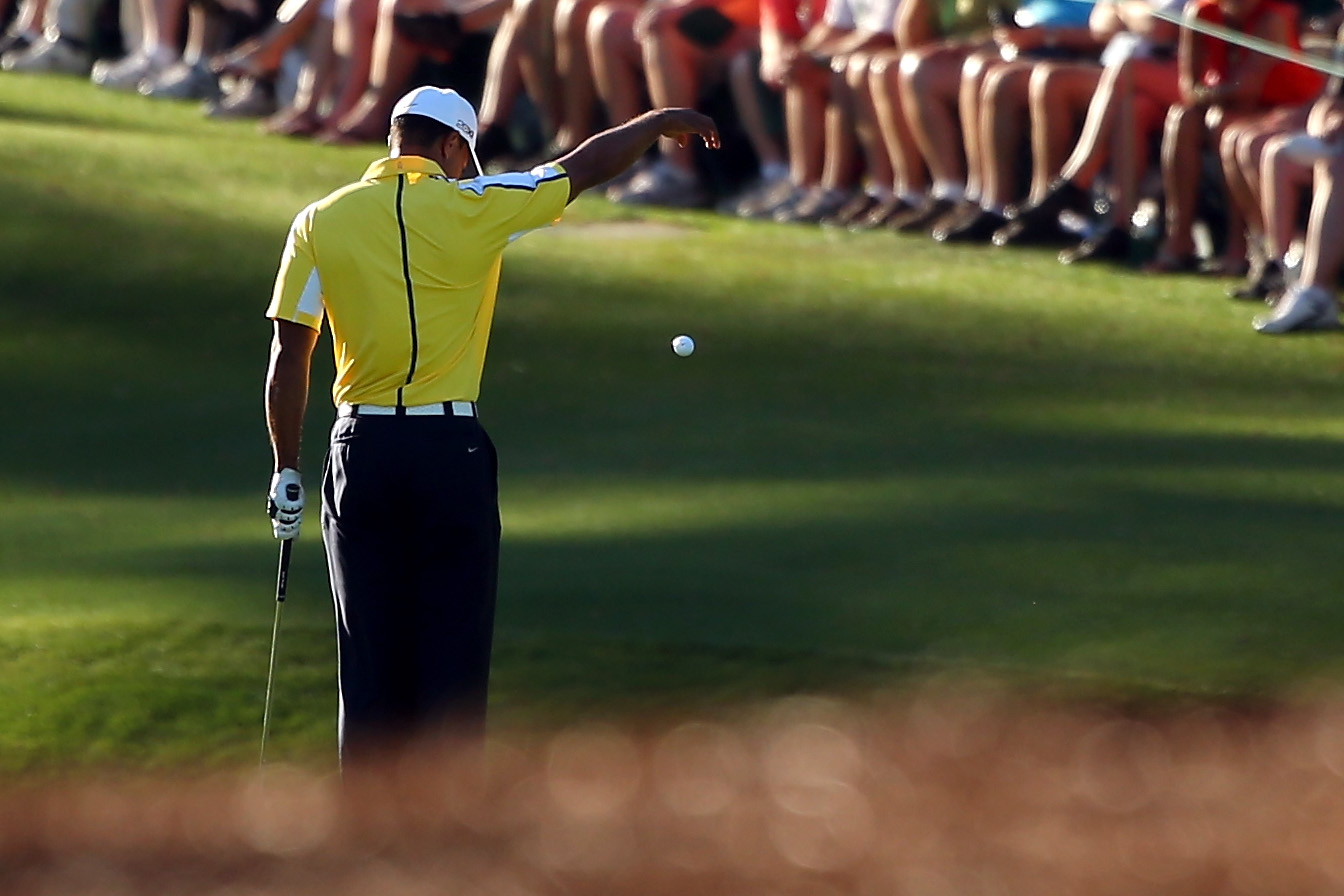
Everyone has their favorite moments from the Masters. But what are the best and worst shots in Masters history for each hole at Augusta National?
From shots that directly impacted the outcome of the tournament, to others that were impossibly shocking, miserable, or symbolic in their own right, every hole has a story to tell.
77 years, over 3,000 different players, and more than one million shots taken. These are the legendary bests and worsts forever etched in Masters lore.
Related: Hole-By-Hole: The Best And Worst Shots In Masters History (Front 9)
No. 10: Camellia – Par 4, 495 yards
The Best
Bubba Watson is a self-described new age redneck. He raps in golf videos, drives the “General Lee” and flies around the golf course in a hovercraft. So it shouldn’t be surprising he dared to even imagine the Looney Tunes shot he pulled off on the second playoff-hole of the 2012 Masters.
Watson was deep in the woods on No. 10 after an errant tee shot. His ball nestled in a bed of straw in a place where Augusta’s pines looked like monsters from Sleepy Hollow. Watson couldn’t even see the green, but he stepped up and just bludgeoned his wedge. The ball screamed 40 yards through the trees, snap-hooked right and soared 115 yards in the air before plummeting softly on the green. Watson then two-putt for par to become the 76th Masters champion.
Watson put himself in position to win on the strength of consecutive birdies on Nos. 13 through 16. But it was his shot at No. 10 that everyone wanted to talk about afterward, including Bubba.
“I’m obviously going to say I’m the only one who can do it,” Watson said. “I’m the only one who had a chance to do it.”
Call that bravado. Call it a Bubba-ism. Watson is a Masters champion with a style as bold as his swing.
The Worst
Scott Hoch was 24 inches from Masters immortality on the first playoff hole of the 1989 Masters. Twenty-four inches from breakfast in the Masters Champions Locker Room. Twenty four agonizing inches, but that might as well been 24 feet.
Hoch greased his Green Jacket gimme entirely outside the hole and 4 feet beyond. It was the shortest putt missed with a chance to win any major championship in history. And when Hoch launched his putter 10 feet in the air, he became the Masters poster boy for putter paralysis.
It was more painful than childbirth to watch. And Hoch said after the playoff, “I’m just glad I don’t carry a gun with me.” Nick Faldo made his 25-foot birdie putt on the next playoff hole and went home as the 53rd Masters champion. Hoch just went home.
No. 11: White Dogwood – Par 4, 505 yards
The Best
The 51st Masters was a modern-day tale of David and Goliath. Larry Mize was a relative unknown, a local kid who ran the scoreboard during the 1972 Masters. Greg Norman was golf’s most dominant player, ranked No. 1 in the world. And with one deadly sling of his wedge in a sudden-death playoff, Mize dropped the giant Norman to his knees.
Initially a three-man playoff, World No. 3 Seve Ballesteros was eliminated on the previous hole. And on No. 11 Norman reached the green first, leaving Mize a choice between playing it safe or going for the jugular. The fresh-faced Mize went for the kill.
Taking aim at the front edge of the green, Mize chipped towards a grassy bank. The ball bounced twice before catching the slope. Then it broke straight for the hole. And when it finally dropped in the cup, Norman was out on his feet.
Mize chipped in from 140 feet, delivering one of the most absurdly fantastic shots in Masters history. The crowd went berserk. Mize danced in disbelief. And the hometown hero became an Augusta legend in 1987.
The Worst
Ben Hogan had a well-documented blueprint for playing “White Dogwood” in 1954. Always aim the approach towards the right fringe of the green. Anything left was too risky with the greenside pond. But in the final round of the 18th Masters, Hogan deviated from the plan and it cost him a potential third Green Jacket.
Hogan heard a tremendous roar from the crowd two groups ahead, and presumed his lead had diminished. So Hogan uncharacteristically fired at the flag and the result was disastrous. Rather than recording par or birdie like he did in the first three rounds, Hogan took a double-bogey six when his ball found the pond.
Hogan lost in an 18-hole playoff with Sam Snead the following afternoon. But that roar from the crowd on Sunday? It wasn’t an eagle roar, or even a birdie roar. It was a roar of approval for a player who went barefoot into Rae’s Creek searching for an errant shot.
No. 12: Golden Bell – Par 3, 155 yards
The Best
Every Masters champion has to successfully navigate “Amen Corner” on Sunday if he’s going to wear the Green Jacket. And at the 56th Masters in 1992, Fred Couples survived this rite of passage with the help of something supernatural.
Couples held a three stroke lead heading towards the treacherous No. 12. But when his tee shot came up short and hit the sloping bank of Rae’s Creek, Couples’ dreams of winning the Masters were about to wash away.
There was really no reason Couples’ ball should have stopped. Nothing was in its way: nothing that anyone could see that is. Ninety nine out of 100 times that ball winds up in a watery grave, but miraculously it held on.
“The biggest break probably of my life,” Couples said afterward.
Couples chipped up to inside a foot and held on to win his first major by two strokes. But Augusta officials could have stopped the tournament right there and declared Couples the winner. His ball was touched by an angel.
The Worst
Tom Weiskopf was known on Tour as “The Towering Inferno.” By Weiskopf’s own admission, he was “spontaneous with his emotions.” And during the opening round of the 44th Masters at No. 12, Weiskopf threw a match in the gas tank.
Weiskopf’s tee shot hit the green, skipped forward and then spun like a Ninja Blender down the bank to drown into Rae’s Creek. Weiskopf dropped from 60 yards and the result was an exact copy of the first. Hop, skip and dunk. Then Weiskopf started percolating. He detonated his third shot in the center of the creek, splashed his fourth shot with a direct-hit and drenched his fifth shot with mainstream perfection.
In the 1980 Masters Weiskopf hit five shots into the water in about a five-minute span, en route to a record-setting 13 on No. 12. And, oh by the way? In Weiskopf’s previous 12 Masters appearances he didn’t hit a single ball in the water on No. 12.
No. 13: Azalea – Par 5, 510 yards
The Best
When your ball is on pine straw and there are two gigantic trees in front of you, the percentage play is to lay up and avoid the big number. But for Phil Mickelson in the final round of the 2010 Masters, the play was to thread the needle and sew up his third Green Jacket.
Greatness or fate took over on No. 13 when Mickelson hooked his 6-iron through the trees, over Rae’s Creek, to four feet from the cup. Mickelson missed his eagle attempt but sunk the birdie. And Mickelson’s one-stroke lead suddenly became a more comfortable two-stroke lead. Mickelson didn’t have to hit that shot. And maybe he shouldn’t have. But “Phil the Thrill” wanted to.
“A great shot is when you pull it off,” Mickelson said afterwards. “A smart shot is when you don’t have the guts to try it.”
It’s hard to argue with that when the guy saying it just won the 74th Masters.
The Worst
Tommy Nakajima was a fierce competitor on the Japanese Tour in 1978. But a comedy of errors in the first round of the 42nd Masters led to Nakajima posting the highest score ever recorded on “Azalea.”
Nakajima’s drive at No. 13 sailed into the woods and forced him to take an unplayable. After Nakajima laid up, his fourth shot flew into Rae’s Creek. Not wanting to take another unplayable, Nakajima hit from the creek and popped the ball in the air. It landed on Nakajima’s foot for a two-stroke penalty.
Nakajima’s next shot hit the creek bank and rolled back where he was standing. The ball didn’t hit Nakajima this time. But Nakajima slammed his club on the water in frustration and was slapped with a two-stroke penalty for grounding his club in a hazard.
Nakajima finally chipped out onto the green, and two-putted to close the book on No. 13 with a perplexing 13. When asked after the round where it all went wrong, Nakajima simply replied, “On the tee.”
No. 14: Chinese Fir – Par 4, 440 yards
The Best
The greatest moment in the history of No. 14 came during the final round of the 1997 Masters when Tiger Woods’ birdie changed the game forever.
Woods’ birdie established a new Masters record for lowest tournament score (270, 18-under). It also set a new Masters record for largest margin of victory (12 strokes) and punctuated Woods’ dominance as the youngest player and first black man to ever win the Green Jacket.
When Jack Nicklaus first set those records in 1965, Bobby Jones said of Nicklaus, “He plays a game with which I am not familiar.” At the 61st Masters, Woods not only played a game with which Nicklaus was not familiar, but he played it in a way that elevated golf to new a cultural plateau.
The Worst
Fred Couples was 46 years old in 2006. He had no trouble keeping up with young guns off the tee. And during the final round of the 70th Masters, Couples hit the ball like a Masters champion. He just didn’t putt like one.
Couples had a four-foot birdie putt on No. 14 to pull within one stroke of leader Phil Mickelson. But he jabbed the putt across the lip and five-feet past the cup. Couples missed his putt coming back for an eventual three-putt bogey.
From tee-to-green, Couples was as good as anyone in the field. But his flat-stick left him sputtering to a third-place finish.
“I didn’t hit the ball like I was 46,” Couples said afterwards. “But I putt like I was 66.”
It was Couples best opportunity for a second green jacket, and would have made him the oldest champion in Masters history.
No. 15: Firethorn – Par 5, 530 yards
The Best
Gene Sarazen knew he caught the ball pure. It left the face like a gunshot and never wavered from its direct line to the pin. When it reached the green, a thunderous roar went up. When it dropped in the cup, the roar was deafening. In the final round of the second Masters in 1935, Sarazen hit “The Shot Heard Round the World.”
Sarazen used a 4-wood from 235 yards to record the first albatross in Masters history. It launched “The Squire” into a 36-hole playoff where Sarazen defeated Craig Wood for his first and only Green Jacket. And most importantly, Sarazen’s double-eagle permanently put the Masters on the map.
Sarazen’s “Do-Do” (that’s what he called his Wilson Turf Rider 4-wood) is in the USGA Museum for generations to marvel at. And in 1955, Augusta National honored Sarazen’s unforgettable shot by dedicating a bridge in his name. “The Sarazen Bridge” is the first bridge to ever be named after a player in Augusta’s history.
The Worst
In 2013, Tiger Woods nearly holed his approach shot for eagle at No. 15. But it hit the flag during the second round of the 77th Masters, and after his ball diabolically caromed off the flag and rolled into the water, Woods’ next shot would become a “Firethorn” in his side.
Woods took his drop and got up-and down for a bogey six, but a television viewer noticed Woods dropped the ball a few yards further back from the pin, a violation of the rule to drop “as close as possible” to the original spot.
Rules officials discussed the drop with Woods, and he admitted to dropping farther back so he wouldn’t hit the flag again. Woods was not disqualified, but a two-stroke penalty was assessed and his score at No. 15 was officially a triple-bogey eight. Woods’ admission set off an ugly storm of controversy, however.
Journalists, commentators, fans and players called for Woods to withdraw for knowingly attempting to circumvent the rules. Woods might have been cheated out of a eagle on No. 15 and a potential fifth Green Jacket, but allegations of Woods cheating himself was the biggest character test of all.
No. 16: Redbud – Par 3, 170 yards
The Best
Tiger Woods was in a final-round battle with Chris DiMarco at the 69th Masters in 2005. And Woods appeared wounded on No. 16 when his 8-iron missed the green long and left. Woods couldn’t take dead-aim at the hole because of the severe slope of the green, but that didn’t mean Woods wouldn’t attack the cup.
Woods picked a spot 25-feet left of the pin and chipped. His ball checked up, broke right and picked up speed toward the hole. Then it slowed to a dead stop… for two seconds. It was golf’s version of the Heisman pose before crossing the goal line. Woods’ ball freakishly dropped over the edge for an impossible birdie.
Woods roared like a gladiator and the crowd went berserk. It took several minutes before any semblance of normalcy returned. Woods ultimately needed a playoff to defeat DeMarco and capture his fourth green jacket. But “in your life…” You know the rest.
The Worst
Greg Norman is the most heartbreaking character in Masters history. And Norman’s legendary low-point occurred in the final round of the 60th Masters.
Norman began play with a six-stroke lead over Nick Faldo, but when Norman arrived at No. 16 it had decomposed into a two-stroke deficit. With only three holes left to get those strokes back, Norman fired at the pin hoping for an ace. Instead he butchered his 6-iron into the water.
In 1996, Norman blew the biggest final-round lead in Masters history. And his 6-iron on No. 16 was the “recognition” of this “Greek Tragedy.”
No. 17: Nandina – Par 4, 440 yards
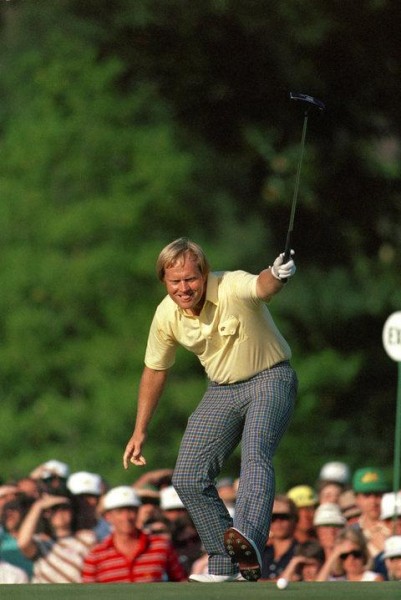
The Best
When Jack Nicklaus arrived at Augusta National for the 50th Masters in 1986, no one gave him any chance of winning. Nicklaus was 46-years old and past his prime, but he was able to roll back the years. And then on No. 17 he rolled in the putt.
Nicklaus found himself locked in a dogfight with Greg Norman, Bernhard Langer, Seve Ballesteros and Tom Kite to start the back-9. But he separated himself from Norman and Langer with a birdie at No. 13, an eagle at No. 15 and another birdie at No. 16. Nicklaus’ charge on the back nine was the greatest stretch of competitive golf ever played.
Then on No. 17, tied for the lead with Ballesteros and Kite, Nicklaus sank the most famous putt in Masters history.
Staring down a double-breaking 12-foot putt with a train whistle screaming in the background and the opportunity for Nicklaus to grab sole possession of the Masters lead for the first time in 11 years, Jack’s killer instinct took over.
Nicklaus gently stroked his mammoth putter, raised his left arm triumphantly in the air and chased his ball down the hole for birdie. He became a a six-time Masters champion, and the signature moment was Jack’s magical putt on No. 17.
The Worst
Stuart Appleby enjoyed a four-stroke advantage to start the third round of the 71st Masters in 2007, but on No. 17 the “Eisenhower Tree” issued a high-command resignation of Appleby’s lead.
Appleby pulled his tee shot so far left it flew over the famous pine and into a greenside bunker one fairway over. Applbey then caught his 9 iron thin out of the bunker and dropped it in a stockpile of pine cones.
It took Appleby two more shots to reach the green, and after he three-putt for a very un-presidential triple-bogey, Applbey said, “Stuff like that happens. That’s Augusta.”
No. 18: Holly – Par 4, 465 yards
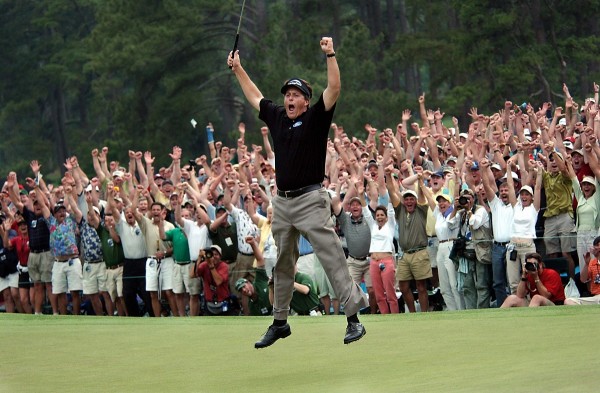
The Best
Phil Mickelson came into the 68th Masters needing a major resuscitation. He was an agonizing 0-for-11 in previous Masters appearances. And in 2004, Mickelson’s putt on No. 18 proved to be a real heart-stopper.
A 20-foot birdie putt on No. 18 was the only thing standing between Mickelson and his first Masters championship, but the odds were not in his favor. Only five players in Masters history had birdied the 72nd hole to win the Green Jacket.
Mickelson’s putt looked like it was going to barely miss left, but it caught a piece of the lip, circled around the hole and dropped in. And Mickelson… well, he hopped.
Maybe the relief of finally winning a major got the best of Mickelson. His jump for joy wasn’t exactly gravity-defying, but it was a Mickelodean moment hard to top in the putt-making celebration category.
The Worst
Arnold Palmer strolled up the fairway during the final round of the 25th Masters confident in his third green jacket coronation. All Palmer had to do was par No. 18 like he’d done the previous three rounds, but “The King” put his head on a chopping block.
Palmer pushed his approach right into the greenside bunker. Then he skulled his bunker shot across the green and into the gallery. Palmer’s next shot raced 15 feet past the hole, and finally Palmer missed a putt that would have at least forced a playoff.
It was a brutal turn of events for Palmer, who finished one stroke behind Masters champion Gary Player. Palmer would still go on to win two more Green Jackets, but in 1961 “The King” could not escape the guillotine.
- LIKE0
- LEGIT0
- WOW2
- LOL0
- IDHT0
- FLOP0
- OB0
- SHANK0
19th Hole
Vincenzi’s 2024 PGA Championship betting preview: Rising star ready to join the immortals at Valhalla

The second major of the 2024 season is upon us as the world’s best players will tee it up this week at Valhalla Golf Club in Louisville, Kentucky to compete for the Wanamaker Trophy.
The last time we saw Valhalla host a major championship, Rory McIlroy fended off Phil Mickelson, Henrik Stenson, Rickie Fowler and the creeping darkness that was descending upon the golf course. The Northern Irishman had the golf world in the palm of his hand, joining only Tiger Woods and Jack Nicklaus as players who’d won four major championships by the time they were 25 years old.
Valhalla is named after the great hall described in Norse mythology where the souls of Vikings feasted and celebrated with the Gods. The course is a Jack Nicklaus-design that has ranked among Golf Digest’s “America’s 100 Greatest Courses” for three decades.
Valhalla Golf Club is a par-71 measuring 7,542 yards with Zoysia fairways and Bentgrass greens. The course has rolling hills and dangerous streams scattered throughout and the signature 13th hole is picturesque with limestone and unique bunkering protecting the green. The 2024 PGA Championship will mark the fourth time Valhalla has hosted the event.
The field this week will consist of 156 players, including 16 PGA Champions and 33 Major Champions.
Past Winners of the PGA Championship
- 2023: Brooks Koepka (-9) Oak Hill
- 2022: Justin Thomas (-5) Southern Hills
- 2021: Phil Mickelson (-6) Kiawah Island
- 2020: Collin Morikawa (-13) TPC Harding Park
- 2019: Brooks Koepka (-8) Bethpage Black
- 2018: Brooks Koepka (-16) Bellerive
- 2017: Justin Thomas (-8) Quail Hollow
- 2016: Jimmy Walker (-14) Baltusrol
- 2015: Jason Day (-20) Whistling Straits
- 2014: Rory McIlroy (-16) Valhalla
In this article and going forward, I’ll be using the Rabbit Hole by Betsperts Golf data engine to develop my custom model. If you want to build your own model or check out all of the detailed stats, you can sign up using promo code: MATTVIN for 25% off any subscription package (yearly is best value).
Key Stats For Valhalla
Let’s take a look at five key metrics for Oak Hill to determine which golfers boast top marks in each category over their past 24 rounds.
1. Strokes Gained: Approach
Valhalla will play as a true all-around test of golf for the world’s best. Of course, it will take strong approach play to win a major championship.
Strokes Gained: Approach Over Past 24 Rounds
- Shane Lowry (+1.25)
- Scottie Scheffler (+1.09)
- Jordan Smith (+1.05)
- Tom Hoge (+.96)
- Corey Conners (+.94)
2. Strokes Gained: Off the Tee
Valhalla will play long and the rough will be penal. Players who are incredibly short off the tee and/or have a hard time hitting fairways will be all but eliminated from contention this week at the PGA Championship.
Strokes Gained: Off the Tee Over Past 24 Rounds:
- Bryson DeChambeau (+1.47)
- Scottie Scheffler (+1.11)
- Keith Mitchell (+.90)
- Alejandro Tosti (+.89)
- Ludvig Aberg (+.82)
Strokes Gained: Total on Nickalus Designs
Valhalla is a classic Nicklaus Design. Players who play well at Nicklaus designs should have an advantage coming into this major championship.
Strokes Gained: Total on Nicklaus Designs over past 36 rounds:
- Jon Rahm (+2.56)
- Scottie Scheffler (+2.48)
- Patrick Cantlay (+2.35)
- Collin Morikawa (+1.79)
- Shane Lowry (+1.57)
Strokes Gained: Tee to Green on Very Long Courses
Valhalla is going to play extremely long this week. Players who have had success playing very long golf courses should be better equipped to handle the conditions of this major championship.
Strokes Gained: Total on Very Long Courses Over Past 24 Rounds:
- Scottie Scheffler (+2.44)
- Rory McIlroy (+2.24)
- Will Zalatoris (+1.78)
- Viktor Hovland (+1.69)
- Xander Schauffele (+1.60)
Strokes Gained: Total in Major Championships
One factor that tends to play a large role in deciding major championships is which players have played well in previous majors leading up to the event.
Strokes Gained: Total in Major Championships over past 20 rounds:
- Scottie Scheffler (+3.14)
- Will Zalatoris (+2.64)
- Rory McIlroy (+2.49)
- Xander Schauffele (+2.48)
- Tommy Fleetwood (2.09)
Strokes Gained: Putting on Bentgrass Greens
Valhalla features pure Bentgrass putting surfaces. Players who are comfortable putting on this surface will have an advantage on the greens.
Strokes Gained: Putting on Bentgrass Greens over Past 24 Rounds:
- Ludvig Aberg (+1.12)
- Denny McCarthy (+1.08)
- Matt Fitzpatrick (+0.99)
- Justin Rose (+0.93)
- J.T. Poston (0.87)
Strokes Gained: Total on Zoysia Fairways
Valhalla features Zoysia fairways. Players who are comfortable playing on this surface will have an advantage on the field.
Strokes Gained: Total on Zoysia Fairways over past 36 rounds:
- Justin Thomas (+1.53)
- Will Zalatoris (+1.47)
- Xander Schauffele (+1.40)
- Brooks Koepka (+1.35)
- Rory McIlroy (+1.23)
2024 PGA Championship Model Rankings
Below, I’ve compiled overall model rankings using a combination of the key statistical categories previously discussed — SG: Approach (25%), SG: Off the Tee (22%), SG: T2G on Very Long Courses (12%), SG: Putting on Bentgrass (+12%), SG: Total on Nicklaus Designs (12%). SG: Total on Zoysia Fairways (8%), and SG: Total in Major Championships (8%).
- Brooks Koepka
- Xander Schauffele
- Rory McIlroy
- Scottie Scheffler
- Bryson DeChambeau
- Shane Lowry
- Alex Noren
- Will Zalatoris
- Cameron Young
- Keith Mitchell
- Hideki Matsuyama
- Billy Horschel
- Patrick Cantlay
- Viktor Hovland
- Adam Schenk
- Chris Kirk
- Sahith Theegala
- Min Woo Lee
- Joaquin Niemann
- Justin Thomas
2024 PGA Championship Picks
Ludvig Aberg +1800 (BetMGM)
At The Masters, Ludvig Aberg announced to the golf world that he’s no longer an “up and coming” player. He’s one of the best players in the game of golf, regardless of experience.
Augusta National gave Aberg some necessary scar tissue and showed him what being in contention at a major championship felt like down the stretch. Unsurprisingly, he made a costly mistake, hitting it in the water left of the 11th hole, but showed his resilience by immediately bouncing back. He went on to birdie two of his next three holes and finished in solo second by three shots. With the type of demeanor that remains cool in pressure situations, I believe Ludvig has the right mental game to win a major at this point in his career.
Aberg has not finished outside of the top-25 in his past eight starts, which includes two runner-up finishes at both a “Signature Event” and a major championship. The 24-year-old is absolutely dominant with his driver, which will give him a major advantage this week. In the field he ranks, in Strokes Gained: Off the Tee, and has gained strokes in the category in each of his past ten starts. Aberg is already one of the best drivers of the golf ball on the planet.
In Norse mythology, Valhalla is the great hall where the souls of Vikings feasted and celebrated with the Gods. The Swedes, who are of Old Norse origin, were the last of the three Scandinavian Kingdoms to abandon the Old Norse Gods. A Swede played a major role in the 2014 PGA Championship at Valhalla, and I believe another, Ludvig Aberg, will be the one to conquer Valhalla in 2024.
Bryson DeChambeau +2800 (BetMGM)
Bryson DeChambeau is one of the few players in the world that I believe has the game to go blow-for-blow with Scottie Scheffler. Although he isn’t as consistent as Scheffler, when he’s at his best, Bryson has the talent to beat him.
At The Masters, DeChambeau put forth a valiant effort at a golf course that simply does not suit his game. Valhalla, on the other hand, is a course that should be perfect for the 30-year-old. His ability to overpower a golf course with his driver will be a serious weapon this week.
Bryson has had some success at Jack Nicklaus designs throughout his career as he won the Memorial at Muirfield Village back in 2018. He’s also had incredible results on Bentgrass greens for the entirety of his professional career. Of his 10 wins, nine of them have come on Bentgrass greens, with the only exception being the Arnold Palmer Invitational at Bay Hill. He also has second place finishes at Medinah and TPC Summerlin, which feature Bentgrass greens.
Love him or hate him, it’s impossible to argue that Bryson isn’t one of the most exciting and important players in the game of golf. He’s also one of the best players in the world. A second major is coming soon for DeChambeau, and I believe he should be amongst the favorites to hoist the Wanamaker Trophy this week.
Patrick Cantlay +4000 (FanDuel)
There’s no way of getting around it: Patrick Cantlay has been dissapointing in major championships throughout his professional career. He’s been one of the top players on Tour for a handful of years and has yet to truly contend at a major championship, with the arguable exception of the 2019 Masters.
Despite not winning majors, Cantlay has won some big events. The 32-year-old has won two BMW Championships, two Memorial Tournaments as well as a Tour Championship. His victories at Memorial indicate how much Cantlay loves Nicklaus designs, where he ranks 3rd in the field in Strokes Gained: Total over his past 36 rounds behind only Scottie Scheffler and Jon Rahm.
Cantlay also loves Bentgrass greens. Six of Cantlay’s seven individual wins on the PGA Tour have come on Bentgrass greens and he also was one of the best putters at the 2023 Ryder cup at Marco Simone (also Bentgrass). At Caves Valley (2021 BMW Championship), he gained over 12 strokes putting to outduel another Bentgrass specialist, Bryson DeChambeau.
Cantlay finished 22nd in The Masters, which was a solid result considering how many elite players struggled that week. He also has two top-ten finishes in his past five PGA Championships. He’s undeniably one of the best players in the field, therefore, it comes down to believing Cantlay has the mental fortitude to win a major, which I do.
Joaquin Niemann +4000 (BetMGM)
I believe Joaquin Niemann is one of the best players in the world. He has three worldwide wins since December and has continued to improve over the course of his impressive career thus far. Still only 25, the Chilean has all the tools to be a serious contender in major championships for years to come.
Niemann has been the best player on LIV this season. Plenty will argue with the format or source of the money on LIV, but no one can argue that beating players such as Jon Rahm, Bryson DeChambeau, Dustin Johnson, Brooks Koepka and Cameron Smith is an unremarkable achievement. Niemann is an elite driver of the golf ball who hits it farther than just about anyone in the field not named Bryson DeChambeau or (arguably) Rory McIlroy.
Niemann is another player who has been fantastic throughout his career on Bentgrass greens. Prior to leaving the PGA Tour, Bentgrass was the only green surface in which Joaco was a positive putter. It’s clearly a surface that he is very comfortable putting on and should fare around and on the greens this week.
Niemann is a perfect fit for Valhalla. His low and penetrating ball flight will get him plenty of runout this week on the fairways and he should have shorter shots into the green complexes than his competitors. To this point in his career, the former top ranked amateur in the world (2018) has been underwhelming in major championships, but I don’t believe that will last much longer. Joaquin Niemann is a major championship caliber player and has a real chance to contend this week at Valhalla.
- LIKE37
- LEGIT15
- WOW4
- LOL1
- IDHT1
- FLOP4
- OB3
- SHANK17
Opinion & Analysis
The Wedge Guy: What really makes a wedge work? Part 2

In my last post, I explained the basic performance dynamics of “smash factor” and “gear effect” as they apply to your wedges and your wedge play success. If you missed that post, you can read it here.
At the end of that post, I promised “part 2” of this discussion of what makes a wedge work the way it does. So, let’s dive into the other two components of any wedge – the shaft and the grip.
It’s long been said that the shaft is “the engine of the golf club.” The shaft (and grip) are your only connection to all the technologies that are packed into the head of any golf club, whether it be a driver, fairway, hybrid, iron, wedge or even putter.
And you cannot ignore those two components of your wedges if your goal is optimizing your performance.
I’ve long been an advocate of what I call a “seamless transition” from your irons into your wedges, so that the feel and performance do not disconnect when you choose a gap wedge, for example, instead of your iron-set-matching “P-club.” In today’s golf equipment marketplace, more and more golfers are making the investment of time and money to experience an iron fitting, going through trial and error and launch monitor measuring to get just the right shaft in their irons.
But then so many of those same golfers just go into a store and choose wedges off the retail display, with no similar science involved at all. And that’s why I see so many golfers with a huge disconnect between their custom-fitted irons, often with lighter and/or softer graphite or light steel shafts . . . and their off-the-rack wedges with the stock stiff steel ‘wedge flex’ shaft common to those stock offerings.
If your wedge shafts are significantly heavier and stiffer than the shafts in your irons, it is physically impossible for you to make the same swing. Period.
To quickly improve your wedge play, one of the first things you can do is have your wedges re-shafted with the same or similar shaft that is in your irons.
There’s another side of that shaft weight equation; if you don’t have the forearm and hand strength of a PGA Tour professional, you simply cannot “handle” the same weight shaft that those guys play to master the myriad of ‘touch shots’ around the greens.
Now, let’s move on to the third and other key component of your wedges – the grips. If those are not similar in shape and feel to the grips on your irons, you have another disconnect. Have your grips checked by a qualified golf club professionals to make sure you are in sync there.
The one caveat to that advice is that I am a proponent of a reduced taper in your wedge grips – putting two to four more layers of tape under the lower hand, or selecting one of the many reduced taper grips on the market. That accomplishes two goals for your scoring.
First, it helps reduce overactive hands in your full and near-full wedge swings. Quiet hands are key to good wedge shots.
And secondly, it provides a more consistent feel of the wedge in your hands as you grip down for those shorter and more delicate shots around the greens. And you should always grip down as you get into those touch shots. I call it “getting closer to your work.”
So, if you will spend as much time selecting the shafts and grips for your wedges as you do choosing the brand, model, and loft of them, your scoring range performance will get better.
More from the Wedge Guy
- The Wedge Guy: What really makes a wedge work? Part 1
- The Wedge Guy: The easiest-to-learn golf basic
- The Wedge Guy: Golf mastery begins with your wedge game
- LIKE6
- LEGIT3
- WOW0
- LOL1
- IDHT1
- FLOP0
- OB0
- SHANK5
19th Hole
Vincenzi’s 2024 Wells Fargo Championship betting preview: Tommy Fleetwood ready to finally land maiden PGA Tour title

The PGA Tour season ramps back up this week for another “signature event,” as golf fans look forward to the year’s second major championship next week.
After two weaker-field events in the Zurich Classic and the CJ Cup Byron Nelson, most of the best players in the world will head to historic Quail Hollow for one of the best non-major tournaments of the year.
Last season, Wyndham Clark won the event by four shots.
Quail Hollow is a par-71 measuring 7,521 yards that features Bermudagrass greens. The tree-lined, parkland style course can play quite difficult and features one of the most difficult three-hole stretches in golf known as “The Green Mile,” which makes up holes 16-18: two mammoth par 4s and a 221-yard par 3. All three holes have an average score over par, and water is in play in each of the last five holes on the course.
The field is excellent this week with 68 golfers teeing it up without a cut. All of the golfers who’ve qualified are set to tee it up, with the exception of Scottie Scheffler, who is expecting the birth of his first child.
Past Winners at Quail Hollow
- 2023: Wyndham Clark (-19)
- 2022: Max Homa (-8)
- 2021: Rory McIlroy (-10)
- 2019: Max Homa (-15)
- 2018: Jason Day (-12)
- 2017: Justin Thomas (-8) (PGA Championship)
- 2016: James Hahn (-9)
- 2015: Rory McIlroy (-21)
Key Stats For Quail Hollow
Strokes Gained: Approach
Strokes gained: Approach will be extremely important this week as second shots at Quail Hollow can be very difficult.
Total SG: Approach Over Past 24 Rounds
- Akshay Bhatia (+1.16)
- Tom Hoge (+1.12)
- Corey Conners (+1.01)
- Shane Lowry (+0.93)
- Austin Eckroat (+0.82)
Strokes Gained: Off the Tee
Quail Hollow is a long course on which it is important to play from the fairway. Both distance and accuracy are important, as shorter tee shots will result in approach shots from 200 or more yards. With most of the holes heavily tree lined, errant drives will create some real trouble for the players.
Strokes Gained: Off the Tee Past 24 Rounds:
- Ludvig Aberg (+0.73)
- Rory McIlroy (+0.69)
- Xander Schauffele (+0.62)
- Viktor Hovland (+0.58)
- Chris Kirk (+0.52)
Proximity: 175-200
The 175-200 range is key at Quail Hollow. Players who can hit their long irons well will rise to the top of the leaderboard.
Proximity: 175-200+ over past 24 rounds:
- Cameron Young (28’2″)
- Akshay Bhatia (29’6″)
- Ludvig Aberg (+30’6″)
- Sam Burns (+30’6″)
- Collin Morikawa (+30’9″)
SG: Total on Tom Fazio Designs
Players who thrive on Tom Fazio designs get a bump for me at Quail Hollow this week.
SG: Total on Tom Fazio Designs over past 36 rounds:
- Patrick Cantlay (+2.10)
- Rory McIlroy (+1.95)
- Tommy Fleetwood (+1.68)
- Austin Eckroat (+1.60)
- Will Zalatoris (+1.57)
Strokes Gained: Putting (Bermudagrass)
Strokes Gained: Putting has historically graded out as the most important statistic at Quail Hollow. While it isn’t always predictable, I do want to have it in the model to bump up golfers who prefer to putt on Bermudagrass.
Strokes Gained: Putting (Bermudagrass) Over Past 24 Rounds:
- Taylor Moore (+0.82)
- Nick Dunlap (+.76)
- Wyndham Clark (+.69)
- Emiliano Grillo (+.64)
- Cam Davis (+.61)
Course History
This stat will incorporate players that have played well in the past at Quail Hollow.
Course History over past 36 rounds (per round):
- Rory McIlroy (+2.50)
- Justin Thomas (+1.96)
- Jason Day (+1.92)
- Rickie Fowler (+1.83)
- Viktor Hovland (+1.78)
Wells Fargo Championship Model Rankings
Below, I’ve compiled overall model rankings using a combination of the five key statistical categories previously discussed — SG: Approach (27%), SG: Off the Tee (23%), SG: Total on Fazio designs (12%), Proximity: 175-200 (12%), SG: Putting Bermuda grass (12%), and Course History (14%).
- Wyndham Clark
- Rory McIlroy
- Xander Schauffele
- Shane Lowry
- Hideki Matsuyama
- Viktor Hovland
- Cameron Young
- Austin Eckroat
- Byeong Hun An
- Justin Thomas
2024 Wells Fargo Championship Picks
Tommy Fleetwood +2500 (DraftKings)
I know many out there have Tommy fatigue when it comes to betting, which is completely understandable given his lack of ability to win on the PGA Tour thus far in his career. However, history has shown us that players with Fleetwood’s talent eventually break though, and I believe for Tommy, it’s just a matter of time.
Fleetwood has been excellent on Tom Fazio designs. Over his past 36 rounds, he ranks 3rd in the field in Strokes Gained: Total on Fazio tracks. He’s also been incredibly reliable off the tee this season. He’s gained strokes in the category in eight of his past nine starts, including at The Masters, the PLAYERS and the three “signature events” of the season. Tommy is a golfer built for tougher courses and can grind it out in difficult conditions.
Last year, Fleetwood was the first-round leader at this event, firing a Thursday 65. He finished the event in a tie for 5th place.
For those worried about Fleetwood’s disappointing start his last time out at Harbour Town, he’s bounced back nicely after plenty of poor outings this season. His T7 at the Valero Texas Open was after a MC and T35 in his prior two starts and his win at the Dubai Invitational came after a T47 at the Sentry.
I expect Tommy to bounce back this week and contend at Quail Hollow.
Justin Thomas +3000 (DraftKings)
It’s been a rough couple of years for Justin Thomas, but I don’t believe things are quite as bad as they seem for JT. He got caught in the bad side of the draw at Augusta for last month’s Masters and has gained strokes on approach in seven of his nine starts in 2024.
Thomas may have found something in his most recent start at the RBC Heritage. He finished T5 at a course that he isn’t the best fit for on paper. He also finally got the putter working and ranked 15th in Strokes Gained: Putting for the week.
The two-time PGA champion captured the first of his two major championships at Quail Hollow back in 2017, and some good vibes from the course may be enough to get JT out of his slump.
Thomas hasn’t won an event in just about two years. However, I still believe that will change soon as he’s been one of the most prolific winners throughout his PGA Tour career. Since 2015, he has 15 PGA Tour wins.
Course history is pretty sticky at Quail Hollow, with players who like the course playing well there on a regular basis. In addition to JT’s PGA Championship win in 2017, he went 4-1 at the 2022 Presidents Cup and finished T14 at the event last year despite being in poor form. Thomas can return as one of the top players on the PGA Tour with a win at a “signature event” this week.
Cameron Young +3500 (DraftKings)
For many golf bettors, it’s been frustrating backing Cam Young this season. His talent is undeniable, and one of the best and most consistent performers on the PGA Tour. He just hasn’t broken through with a victory yet. Quail Hollow has been a great place for elite players to get their first victory. Rory McIlroy, Anthony Kim, Rickie Fowler and Wyndham Clark all notched their first PGA Tour win at Quail.
Throughout Cam Young’s career, he has thrived at tougher courses with strong fields. This season, he finished T16 at Riviera and T9 at Augusta National, demonstrating his preference of a tough test. His ability to hit the ball long and straight off the tee make him an ideal fit for Quail Hollow, despite playing pretty poorly his first time out in 2023 (T59). Young should be comfortable playing in the region as he played his college golf at Wake Forest, which is about an hour’s drive from Quail Hollow.
The 26-year-old has played well at Tom Fazio designs in the past and ranks 8th in the field in Strokes Gained: Total on those courses in his last 36 rounds. Perhaps most importantly, this season, Young is the best player on the PGA Tour in terms of proximity from 175-200 in the fairway, which is where a plurality and many crucial shots will come from this week.
Young is an elite talent and Quail Hollow has been kind to players of his ilk who’ve yet to win on Tour.
Byeong Hun An +5000 (FanDuel)
Byeong Hun An missed some opportunities last weekend at the CJ Cup Byron Nelson. He finished T4 and played some outstanding golf, but a couple of missed short putts prevented him from getting to the winning score of -23. Despite not getting the win, it’s hard to view An’s performance as anything other than an overwhelming success. It was An’s fourth top-ten finish of the season.
Last week, An gained 6.5 strokes ball striking, which was 7th in the field. He also ranked 12th for Strokes Gained: Approach and 13th for Strokes Gained: Off the Tee. The South Korean has been hitting the ball so well from tee to green all season long and he now heads to a golf course that should reward his precision.
An’s driver and long irons are absolute weapons. At Quail Hollow, players will see plenty of approach shots from the 175-200 range as well as some from 200+. In his past 24 rounds, Ben ranks 3rd in the field in proximity from 175-200 and 12th in proximity from 200+. Playing in an event that will not end up being a “birdie” fest should help An, who can separate from the field with his strong tee to green play. The putter may not always cooperate but getting to -15 is much easier than getting to -23 for elite ball strikers who tend to struggle on the greens.
Winning a “signature event” feels like a tall task for An this week with so many elite players in the field. However, he’s finished T16 at the Genesis Invitational, T16 at The Masters and T8 at the Arnold Palmer Invitational. The 32-year-old’s game has improved drastically this season and I believe he’s ready to get the biggest win of his career.
- LIKE9
- LEGIT4
- WOW1
- LOL1
- IDHT1
- FLOP1
- OB0
- SHANK1
-
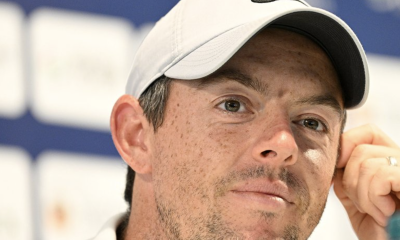
 19th Hole3 days ago
19th Hole3 days agoBrandel Chamblee says this is the primary reason why Rory McIlroy hasn’t won a major in 10 years
-

 Whats in the Bag4 days ago
Whats in the Bag4 days agoTiger Woods WITB 2024 (May)
-

 19th Hole2 weeks ago
19th Hole2 weeks agoReport: LIV star turns down PGA Championship invite due to ‘personal commitments’
-

 19th Hole2 weeks ago
19th Hole2 weeks agoGary Player claims this is what ‘completely ruined’ Tiger Woods’ career
-

 Equipment1 week ago
Equipment1 week agoDetails on Justin Thomas’ driver switch at the Wells Fargo Championship
-

 News1 day ago
News1 day agoScottie Scheffler arrested, charged, and released after traffic incident at Valhalla
-

 Whats in the Bag3 weeks ago
Whats in the Bag3 weeks agoTeam McIlowry (Rory McIlroy, Shane Lowry) winning WITBs: 2024 Zurich Classic
-

 Whats in the Bag2 weeks ago
Whats in the Bag2 weeks agoKeegan Bradley WITB 2024 (May)

